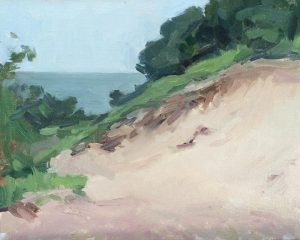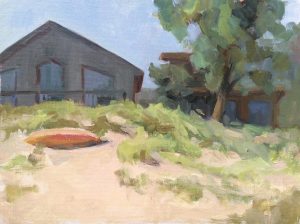My Experiences as an Indiana Dunes National Lakeshore Artist-In-Residence
by Anne-Karine Bley
 What would it feel like to be able to paint all day without any distractions? To go wherever I liked, knowing that I was permitted, expected in fact, to be an artist and nothing more. This was the question that led me to seek out an artist-in-residence with the Indiana Dunes National Lakeshore.
What would it feel like to be able to paint all day without any distractions? To go wherever I liked, knowing that I was permitted, expected in fact, to be an artist and nothing more. This was the question that led me to seek out an artist-in-residence with the Indiana Dunes National Lakeshore.
I wasn’t sure what to expect from the program. I knew that I would get a tour of the park properties and a place to stay. In return I would be asked to donate a piece of art to the Park’s permanent collection. I didn’t really need to know anything else because all I wanted was to paint. In mid-July I arrived open minded and enthusiastic.
There were new questions now. What should I paint? Where should I go first? Is my gear too heavy for me to take on that trail? I wanted to do it all and I only had two weeks. In the end there was no need for further planning. The luxury of living in the park was the tremendous diversity of subjects. Within minutes of my doorstep were beaches, dunes, woodlands, marsh, inland lakes and historic buildings. Not surprisingly, the Dunes National Lakeshore is ranked seventh in biodiversity.
It didn’t take long before a natural routine developed and I started to know what it felt like to paint all day. I painted a lot. I pushed myself to keep painting and take advantage of every moment. The questions evolved and now I was asking ‘What am I learning about myself?’, ‘What do I know about the way I paint?’ and ‘What is true and genuine about my work?’ I challenged myself to compose regardless of the location or the weather. I lugged my French easel everywhere I went. I experimented with painting a series of sunsets and skies. When I was done with the canvases, they were put away out of sight and without judgement.
I did take breaks. Not only were they essential to the rhythm of my day but the park service expected me to explore and enjoy the properties. And I did have visitors, including some fellow BWS members. (A special thank you to those who came up to the Dunes!) With only a few exceptions I was able to visit all the major properties. Not to be missed are Cowles Bog Trail and Porter beach. There were local offerings too. I made new friends among the local plein air group. I attended a demo at the Chesterton Art Gallery. And I toured the works of local legend Hazel Hannell who painted up until her death at the age of 106.
There is probably one other question that you are wondering about: ‘What was it like to paint in such a public setting?” Plein air painting is unusual and people are curious, so naturally I was regularly approached by the public. I understood these interactions to be part of my function as the artist-in-residence and perhaps surprisingly it was one of the most enriching aspects of the program. Each day I found myself having meaningful and sometime passionate conversations with all types of people from all over the country. Many of these exchanges touched on the complicated relationship with neighbors that has shaped the park from its origins.
The park was created in 1966 and incorporated many private communities that have been returned to the nature landscape. The remaining landowners do not always share the same mission as the park. Some are even combative. Consider also that the park stretches across three counties, 30 municipalities and around major industries most notably the steel mills and the port of Indiana.
The contrast of industry and nature is obvious when you look down the shoreline. In either direction looms some sort of smoke stack or cooling tower. The struggle for balance between public and private is clearly indicated along the beaches where signage reads ‘private’, ’keep off dune’ or ‘keep out’. This is what many people wanted to talk about. One of those people was a homeowner whose bungalow was right behind the foredune and was the subject of my painting. When he approached me he might have been curious but he was definitely protective. He had strong feelings about the park. He felt threatened by the park and was unhappy. I could empathize with this gentleman but his position was in contrast to my own. I love the park and I value the role the park service is playing to restore and preserve natural spaces. That painting is the painting I have selected to donate. I chose it because it best exemplifies my work and skill at this time but somehow, unintentionally, also it speaks to the story of these opposing points of view.
Now that I am back home the opposition I face is between artistic and familial demands. The intense focus on painting is gone. Now there is reflection and assessment. I can acknowledge what I have accomplished and I have an answer to that first question: What would it feel like to paint all day without any distractions? To go wherever I liked, knowing that I was permitted, expected in fact, to be an artist. It felt like exactly what I needed and what I will strive for in the future.
*BWS members wanting to know more about the application process or specific questions about the program may contact me for more information.
Further reading:
park website: https://www.nps.gov/indu/index.htm
‘The Indiana Dunes Revealed, The Art of Frank V. Dudley’, Brauer Museum of Art, Valparaiso University